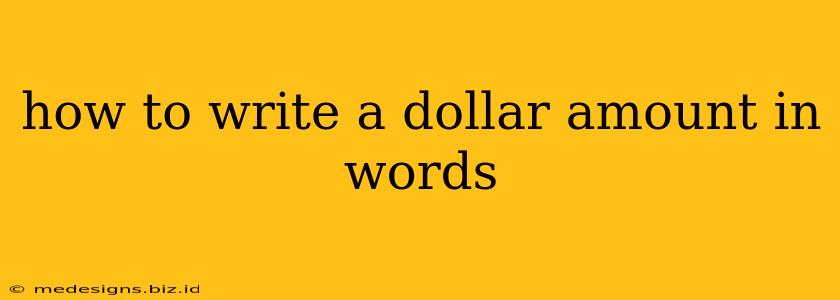Writing dollar amounts in words might seem straightforward, but there are nuances and specific conventions to follow, especially for formal documents or legal contexts. This guide will walk you through the process, covering various scenarios and offering helpful tips to ensure accuracy and clarity.
Why Write Dollar Amounts in Words?
While numerals are often sufficient, writing dollar amounts in words adds a layer of formality and reduces the risk of errors or ambiguity. This is particularly important in:
- Legal Documents: Contracts, checks, and other legal documents often require dollar amounts to be written both numerically and in words to prevent fraud or disputes.
- Formal Letters and Correspondence: Using words adds a professional touch and minimizes the possibility of misinterpretations.
- Financial Statements: For clarity and to avoid confusion, financial reports often use both numerical and written forms.
Basic Rules for Writing Dollar Amounts in Words
The fundamental approach involves spelling out the dollar amount followed by "dollars" and then writing out the cents as a fraction or in words after "and".
Example:
- $125.50 is written as: One hundred twenty-five dollars and fifty cents.
Key Considerations:
- Hyphenation: Use hyphens to connect numbers twenty-one through ninety-nine (e.g., twenty-five, ninety-nine).
- Numbers less than one dollar: For amounts less than a dollar, write "zero dollars and" followed by the cents. For example, $0.75 is written as Zero dollars and seventy-five cents.
- Millions, billions, etc.: For larger sums, maintain the same pattern. For example, $1,500,000 is written as One million, five hundred thousand dollars.
Handling Different Scenarios
Let's explore some specific scenarios and how to address them correctly:
1. Writing large dollar amounts in words
For large sums of money, it's crucial to maintain clarity and avoid confusion. Break down the amount into its constituent parts (millions, thousands, hundreds, etc.) and write it out word-for-word.
Example:
- $12,345,678.90 becomes Twelve million, three hundred forty-five thousand, six hundred seventy-eight dollars and ninety cents.
2. Writing fractions of a dollar in words
When dealing with fractions of a dollar, spell out the fraction.
Example:
- $0.25 can be written as Twenty-five cents or Zero dollars and twenty-five cents. Both are correct but the first is shorter and generally preferred unless strict formality is needed.
3. Writing checks
Checks require particular attention to detail. Always write the amount both numerically and in words, making sure both figures match precisely to prevent discrepancies. Any space left blank can be exploited for fraud. Start the written amount close to the dollar amount space to avoid leaving open space.
4. Using commas and periods
Commas are used to separate large numbers (thousands, millions, etc.), and a period separates the whole dollar amount from the cents. However, these are largely for the numeric representation. When spelling out dollar amounts, you use words and commas to structure the expression of the number.
Tips for Avoiding Errors
- Double-check: Always double-check your work to ensure accuracy. Read the number in words back and then convert it to numerals to make sure it matches the original.
- Use a spell-checker: While a spell-checker won't catch all errors, it can help identify typos.
- Seek assistance when needed: If you are unsure about how to write a particular amount, seek guidance from a professional.
By following these guidelines, you can confidently write dollar amounts in words and maintain accuracy and professionalism in all your written communications. Remember, clarity and precision are crucial, particularly in financial and legal contexts.
